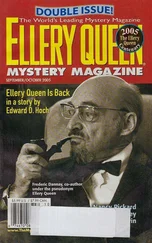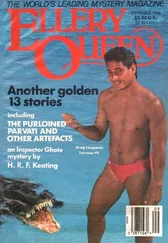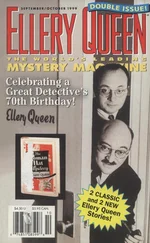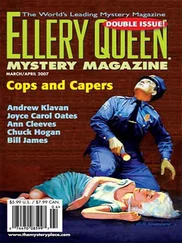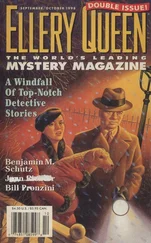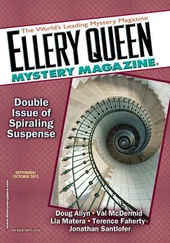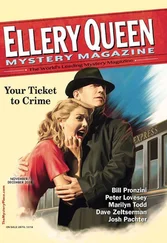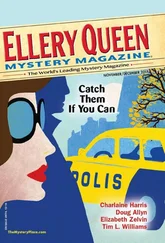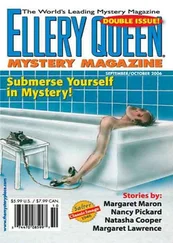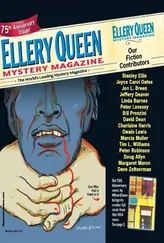William Bankier - Ellery Queen’s Mystery Magazine, Vol. 110, No. 3 & 4. Whole No. 673 & 674, September/October 1997
Здесь есть возможность читать онлайн «William Bankier - Ellery Queen’s Mystery Magazine, Vol. 110, No. 3 & 4. Whole No. 673 & 674, September/October 1997» весь текст электронной книги совершенно бесплатно (целиком полную версию без сокращений). В некоторых случаях можно слушать аудио, скачать через торрент в формате fb2 и присутствует краткое содержание. Город: New York, Год выпуска: 1997, Издательство: Dell Magazines, Жанр: Детектив, на английском языке. Описание произведения, (предисловие) а так же отзывы посетителей доступны на портале библиотеки ЛибКат.
- Название:Ellery Queen’s Mystery Magazine, Vol. 110, No. 3 & 4. Whole No. 673 & 674, September/October 1997
- Автор:
- Издательство:Dell Magazines
- Жанр:
- Год:1997
- Город:New York
- ISBN:нет данных
- Рейтинг книги:4 / 5. Голосов: 1
-
Избранное:Добавить в избранное
- Отзывы:
-
Ваша оценка:
- 80
- 1
- 2
- 3
- 4
- 5
Ellery Queen’s Mystery Magazine, Vol. 110, No. 3 & 4. Whole No. 673 & 674, September/October 1997: краткое содержание, описание и аннотация
Предлагаем к чтению аннотацию, описание, краткое содержание или предисловие (зависит от того, что написал сам автор книги «Ellery Queen’s Mystery Magazine, Vol. 110, No. 3 & 4. Whole No. 673 & 674, September/October 1997»). Если вы не нашли необходимую информацию о книге — напишите в комментариях, мы постараемся отыскать её.
Ellery Queen’s Mystery Magazine, Vol. 110, No. 3 & 4. Whole No. 673 & 674, September/October 1997 — читать онлайн бесплатно полную книгу (весь текст) целиком
Ниже представлен текст книги, разбитый по страницам. Система сохранения места последней прочитанной страницы, позволяет с удобством читать онлайн бесплатно книгу «Ellery Queen’s Mystery Magazine, Vol. 110, No. 3 & 4. Whole No. 673 & 674, September/October 1997», без необходимости каждый раз заново искать на чём Вы остановились. Поставьте закладку, и сможете в любой момент перейти на страницу, на которой закончили чтение.
Интервал:
Закладка:
“Disgraceful,” someone else said. “Can’t walk along the Embankment without stumbling over them.”
At which point our hostess stumbled into the silence to reveal that she had a surprise. “We’ll take coffee and brandy in the morning room, during which you’ll be invited to take part in a murder.”
She didn’t mean it, of course, though more than one pair of eyes strayed to the Docklanders, more in hope than expectation. What she meant was that we’d be participating in a parlour game. There had been a murder (her unsmiling husband the cajoled corpse, miraculously revivified whenever another snifter of brandy was offered) and we were to look for clues in the room. We duly searched, somewhat in the manner of children who wish to please their elders. With half a dozen clues gathered, the Docklands woman surprised us all by deducing that our hostess had committed the crime — as indeed she had.
We collapsed thankfully onto the sofas and had our glasses refilled, after which the conversation came around to crime — real and imagined. It was now that the host became animated for the first time that night. He was a collector of whodunits and fancied himself an expert.
“The perfect crime,” he told us, “as everyone knows, is one where no crime has been committed.”
“But then there is no crime,” his wife declared.
“Precisely,” he said. “No crime... and yet a crime. If the body’s never found, damned hard to convict anyone. Or if something’s stolen, but never noticed. See what I’m getting at?”
I did, of course, and perhaps you do, too.
The Tate, like every other gallery I can think of, has considerably less wall space than it has works in its collection. These days, we do not like to cram our paintings together (though when well done, the effect can be breathtaking). One large canvas may have a whole wall to itself, and praise be that Bacon’s triptychs did not start a revolution, or there’d be precious little work on display in our galleries of modern art. For every display of gigantism, it is blessed relief, is it not, to turn to a miniaturist? Not that there are many miniatures in the Tate’s storerooms. I was there with an acquaintance of mine, the dealer Gregory Jance.
Jance worked out of Zurich for years, for no other reason, according to interviews, than that “they couldn’t touch me there.” There had always been rumours about Jance, rumours which started to make sense when you tried to balance his few premier-league sales (and therefore commissions) against his lavish lifestyle. These days, he had homes in Belgravia, Manhattan’s Upper East Side, and Moscow, as well as a sprawling compound on the outskirts of Zurich. The Moscow home seemed curious until one recalled stories of ikons smuggled out of the old Soviet Union and of art treasures taken from the Nazis, treasures which had ended up in the hands of Politburo chiefs desperate for such things as hard dollars and new passports.
Yes, if even half the tales were true, then Gregory Jance had sailed pretty close to the wind. I was counting on it.
“What a waste,” he said as I gave him a short tour of the storerooms. The place was cool and hushed, except for the occasional click of the machines which monitored air temperature, light, and humidity. On the walls of the Tate proper, paintings such as those we passed now would be pored over, passed by with reverence. Here, they were stacked one against the other, mostly shrouded in white sheeting like corpses or Hamlet’s ghost in some shoddy student production. Identifier tags hung from the sheets like so many items in a lost-property office.
“Such a waste,” Jance sighed, with just a touch of melodrama. His dress sense did not lack drama either: crumpled cream linen suit, white brogues, screaming red shirt, and white silk cravat. He shuffled along like an old man, running the rim of his panama hat through his fingers. It was a nice performance, but if I knew my man, then beneath it he was like bronze.
Our meeting — en principe — was to discuss his latest crop of “world-renowned artists.” Like most other gallery owners — those who act as agents for certain artists — Jance was keen to sell to the Tate, or to any other “national” gallery. He wanted the price hike that came with it, along with the kudos. But mostly the price hike.
He had Polaroids and slides with him. In my office, I placed the slides on a lightbox and took my magnifier to them. A pitiful array of semi-talent dulled my eyes and my senses. Huge graffiti-style whorls which had been “in” the previous summer in New York (mainly, in my view, because the practitioners tended to die young). Some neo-cubist stuff by a Swiss artist whose previous work was familiar to me. He had been growing in stature, but this present direction seemed to me an alley with a brick wall at the end, and I told Jance as much. At least he had a nice sense of colour and juxtaposition. But there was worse to come: combine paintings which Rauschenberg could have constructed in kindergarten; some not very clever geometric paintings, too clearly based on Stella’s “Protractor” series, and “found” sculptures that looked like Nam June Paik on a very bad day.
Throughout, Jance was giving me his pitch, though without much enthusiasm. Where did he collect these people? (The unkind said he sought out the least popular exhibits at art-school graduation shows.) More to the point, where did he sell them? I hadn’t heard of him making any impact at all as an agent. What money he made, he seemed to make by other means.
Finally, he lifted a handful of Polaroids from his pocket. “My latest find,” he confided. “Scottish. Great future.”
I looked through them. “How old?”
He shrugged. “Twenty-six, twenty-seven.”
I deducted five or six years and handed the photos back. “Gregory,” I said, “she’s still at college. These are derivative — evidence she’s learning from those who have gone before — and stylised, such as students often produce. She has talent, and I like the humour, even if that too is borrowed from other Scottish artists.”
He seemed to be looking in vain for the humour in the photos.
“Bruce McLean,” I said helpfully, “Paolozzi, John Bellany’s fish. Look closely and you’ll see.” I paused. “Bring her back in five or ten years, if she’s kept hard at it, if she’s matured, and if she has that nose for the difference between genius and sham....”
He pocketed the photos and gathered up his slides, his eyes glinting as though there might be some moisture there.
“You’re a hard man,” he told me.
“But a fair one, I hope. And to prove it, let me buy you a drink.”
I didn’t put my proposition to him quite then, of course, not over coffee and sticky cakes in the Tate cafeteria. We met a few weeks later — casually, as it were. We dined at a small place in a part of town neither of us frequented. I asked him about his young coterie of artists. They seemed, I said, quite skilled in impersonation.
“Impersonation?”
“They have studied the greats,” I explained, “and can reproduce them with a fair degree of skill.”
“Reproduce them,” he echoed quietly.
“Reproduce them,” I said. “I mean, the influences are there.” I paused. “I’m not saying they copy. ”
“No, not that.” Jance looked up from his untouched food. “Are you coming to some point?”
I smiled. “A lot of paintings in the storerooms, Gregory. They so seldom see the light of day.”
“Yes, pity that. Such a waste.”
“When people could be savouring them.”
He nodded, poured some wine for both of us. “I think I begin to see,” he said. “I think I begin to see.”
That was the start of our little enterprise. You know what it was, of course. You have a keen mind. You are shrewd and discerning. Perhaps you pride yourself on these things, on always being one step ahead, on knowing things before those around you have perceived them. Perhaps you, too, think yourself capable of the perfect crime, a crime where there is no crime.
Читать дальшеИнтервал:
Закладка:
Похожие книги на «Ellery Queen’s Mystery Magazine, Vol. 110, No. 3 & 4. Whole No. 673 & 674, September/October 1997»
Представляем Вашему вниманию похожие книги на «Ellery Queen’s Mystery Magazine, Vol. 110, No. 3 & 4. Whole No. 673 & 674, September/October 1997» списком для выбора. Мы отобрали схожую по названию и смыслу литературу в надежде предоставить читателям больше вариантов отыскать новые, интересные, ещё непрочитанные произведения.
Обсуждение, отзывы о книге «Ellery Queen’s Mystery Magazine, Vol. 110, No. 3 & 4. Whole No. 673 & 674, September/October 1997» и просто собственные мнения читателей. Оставьте ваши комментарии, напишите, что Вы думаете о произведении, его смысле или главных героях. Укажите что конкретно понравилось, а что нет, и почему Вы так считаете.

